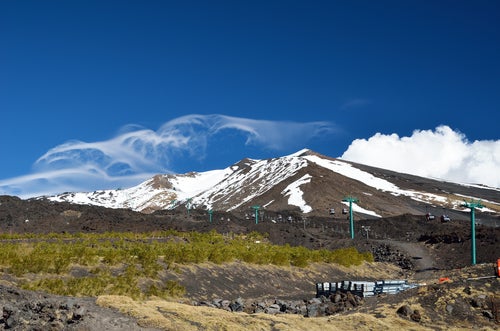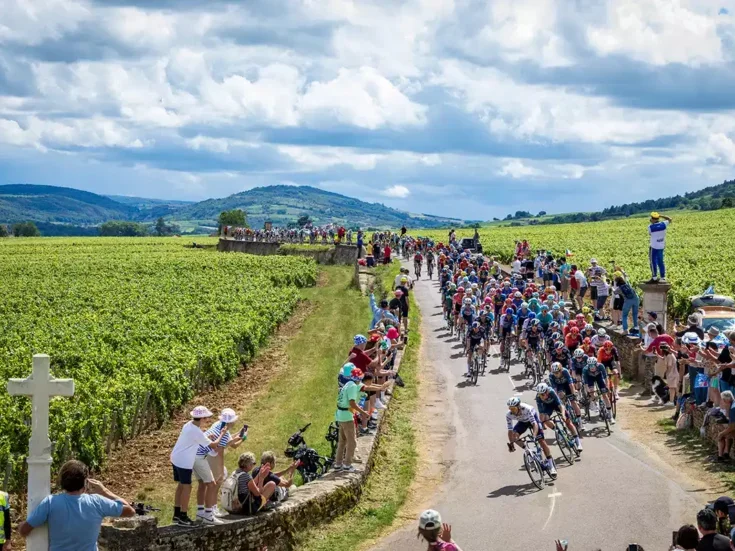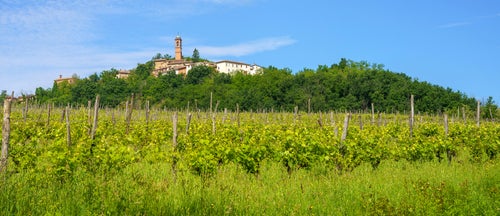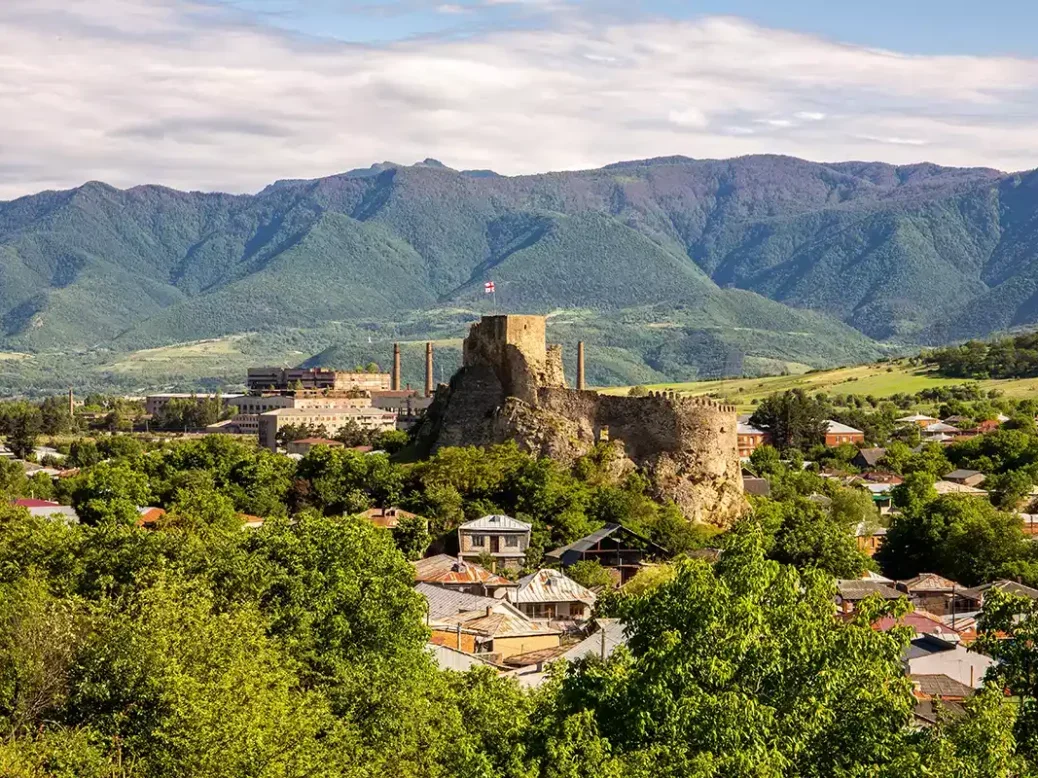
The Kakheti region has so far attracted most attention to modern Georgian wine, but could the distinctive wines made in around the capital Tbilisi in Kartli be the country’s next big thing?
Visitors to the Caucasian country of Georgia—and especially those who are wine devotees—typically spend a few days in its bustling capital, Tbilisi, and then head eastward over the mountains for Kakheti. This powerhouse region is home to the amber (or orange) wines of extended skin contact, and it is where 70% of the country’s wine is produced. Most visitors have no clue that Tbilisi itself is in the center of a distinctive wine region: Kartli.
Known to classical authors as “Iberia,” Kartli was a separate kingdom from antiquity through to the 18th century, and it is now poised to rival its neighbor to the east in quality and accessibility. Yes, there are vines growing in the capital city, and plenty of people have little wine cellars (known as maranis) in their apartments, but it’s a short drive outside the city that the real action is taking place. Whether one heads north or south from Tbilisi, vineyards and serious wineries are less than an hour away. To the north, one finds the Ateni Gorge, Kartli’s first appellation (and Georgia’s only appellation for sparkling wine). To the south, the Stone Age settlement of Gadachrili Gora is testament to Georgia’s claim of being the birthplace of wine; it is there that archeologists unearthed clay shards and pottery with the residue of grapes and wine in the new protected denomination of origin (PDO) of Bolnisi. As Niko Chochishvili of Kapistoni proudly notes, “Kartli is covered with different terroirs that we are only just beginning to understand.”
The Likhi mountain range (below) walls Kartli off from the region of Imereti to its west, and it blocks the humid air coming from the Black Sea, reducing the risk of fungal diseases. To the east, the Iori River and the Tsiv-Gombori mountain range divide it from Kakheti, keeping that region’s warmer air and hail-prone climate at bay. Kartli itself is divided into two main regions: Shida (Inner) Kartli is north of Tbilisi and includes the municipalities of Mtskheta, Gori, and Dzalisa, a Roman settlement from the 4th to the 1st centuries bce. Kvemo (Lower) Kartli, to the south, spans the lower basin of the Mtkvari River. Here we find the historic wine town of Bolnisi and the ancient settlement of Dmanisi, home to a 1.8-million-year-old hominid site.
Niko and I drive around Kartli exploring tiny family vineyard plots tucked within rolling hills or sloping down riverbanks. He spreads his arms wide: “Everywhere you look, there used to be vineyards. There were also a couple of big state cooperatives in Kartli, where grapes from all over were ‘processed’ when Georgia was still part of the Soviet Union.” Two Soviet-era “wine factories” outside Tbilisi still operate, offering a unique view of 20th-century mass production. “The Soviets ripped up a lot of vineyards and planted potatoes and vegetables,” Niko adds. “But some people were emotionally attached to their plots and kept some of these old vines or replanted with local varieties when Georgia became independent again in 1991.”
Niko knows the vineyards like the back of his hand. He’s now retired from the military, but during his service he scoured the region time and again because it borders southern Russia; a Russian military base is visible just a few kilometers from one of his vineyards. Plenty of other vineyards are proximate to Tskhinvali, historically a Georgian (and multicultural) town that has been occupied by Russia since the war in 2008. Intrepid travelers be advised: Following the conflict, the Russians erected numerous border-crossing warning signs in Georgian territory prohibiting entry. To go beyond these signs invites arrest—or worse.
Kartli’s terroirs are quite diverse. Apart from differing soils, vineyard plots sit at different altitudes—but a key element in Kartli is sun exposure. The best vineyard sites, Niko notes, tend to be south-facing slopes not far from the rivers, so they enjoy optimal exposure and favorable air flow, yielding wines with an elegant structure and a vibrant central nervous system. Kartli wines tend to be naturally fresh middleweight wines, with moderate alcohol levels and often with a fine strand of minerality. Niko’s own Kapistoni Shavkapito—a fresh red wine with delicate tannins and soft, dark-berried fruits—pairs perfectly with the classic mtsvadi—pork skewers grilled over a bed of dried grapevine cuttings. His Asuretuli Shavi, another local red variety named for the village of Asureti, is more firmly structured, with higher acidity and crispy tannins transporting a bouquet of violets, dark berries, and cassis to the palate.
“For years, I’ve been saying Kartli will be the next big thing,” says Giorgi (Goga) Tevzadze of Tevza Winery. “People enjoy these lighter, fresher wines with bright flavors.” Goga has a broad background in the wine business, having worked on big projects in Kakheti and spent two years in graduate studies with Roger Boulton of UC Davis. As well as his small family winery, inspired by his California experience, he started Crush 525, Georgia’s first custom-crush operation.
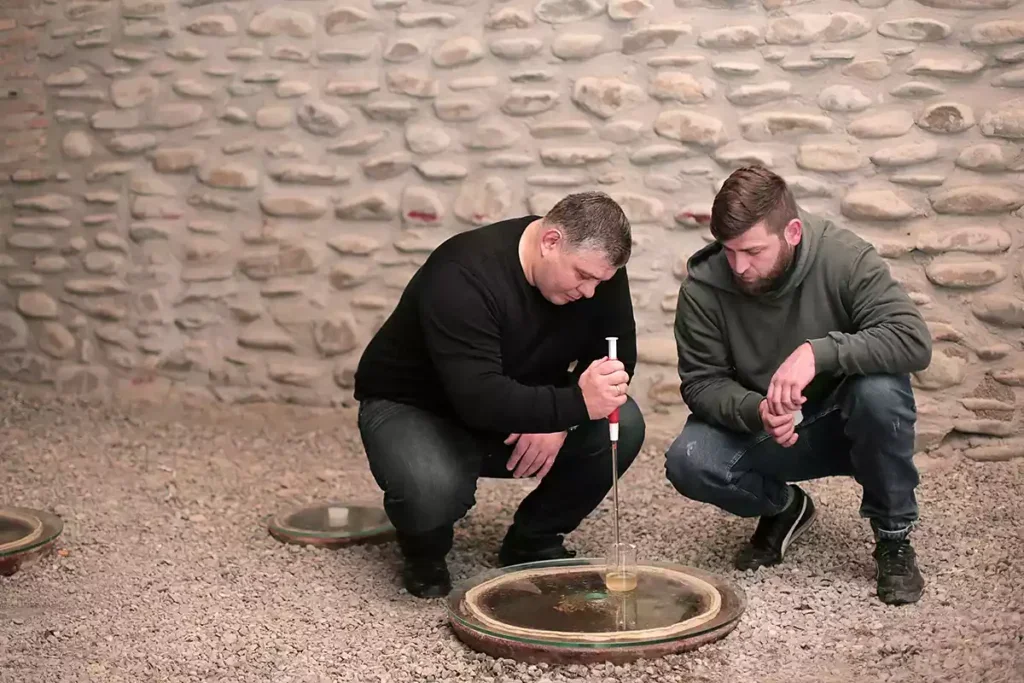
Northwest of Tbilisi, after the highway feeds into village roads, and the village roads segue into dirt pathways, individual plots dot the steep hillsides. In the tiny 11th-century village of Ateni, Giorgi Revazashvili tends terraced mounds of local varieties—the white Goruli Mtsvane and Chinebuli, plus the red Tavkveri—some planted by his grandfather, who taught him about grape growing and winemaking. A nippy breeze wafts through the pergola-trained vines, each around 5–6ft (1.5–1.8m) tall. His tiny, rudimentary marani, tucked into the mountainside, is an earthen warren, worlds removed from the modernizing capital. Happy up on the hillside, Giorgi also seems a step detached from the world, his mind floating on a different wavelength. As with many Georgians, his Christian faith is a significant part of his identity, and wine’s symbolism touches him deeply. Asked why he became a winemaker, he responds, “It brings me closer to the Divine.”
Kartli: Distinctive traditions and the search for terroir
As well as having different growing conditions and different grape varieties, winemaking practices in Kartli also differ from those in Kakheti. Most notable is a tradition for less skin contact. “Our tradition was 80/20,” Giorgi notes. “We used 80% juice, 20% skins and stems, and only for a few months. Of course, it depended on the vintage, whether it would be for one month or three, but not as long as in Kakheti.” Similarly at Samtavisi Marani, named for the local village: “Our tradition was 80% juice and 20% crushed grapes,” says Mamuka Kikvadze.
Both Giorgi and Mamuka are members of the Natural Wine Association (NWA), an active Georgian group of family winemakers committed to non-interventionist grape-growing and wine-producing methods. Like many in the association, they are not trained winemakers. They rely on advice from their forebears, often farming their family plots. For these winemakers, strict adherence to the tradition is worth the risk that excessive volatility, ethyl acetate, or a bit of mousiness may appear in their wines. Mamuka, unlike some of his compatriots in the NWA, doesn’t have relatives upon whom he can rely for vines or advice, but he channels the past in other ways. He recently acquired a new property that has been fallow and pesticide- and herbicide-free for many years. Even if Mamuka isn’t working with family land and know-how, his “vineyard manager was the head of the local collective farm decades back, so he knows these lands, how they were farmed, and how they should be cared for.”
Another unique Kartli winemaking technique is fermenting white wines on the skins (and perhaps a small proportion of stems) of black grapes. This technique is mostly associated with the village of Khidistavi, where the white Goruli Mtsvane and Chinuri grapes ferment on red Tavkveri skins. At Samtavisi, Mamuka is fermenting Chinuri on Shavkapito stems. “This is my rosé experiment,” he says with a wink. In the past, he’s used 25% skins, but for the 2023 vintage he used only 10%; early qvevri samples suggest a vivacious wine with notes of pink grapefruit, hints of red berries, and a light, mineral energy.
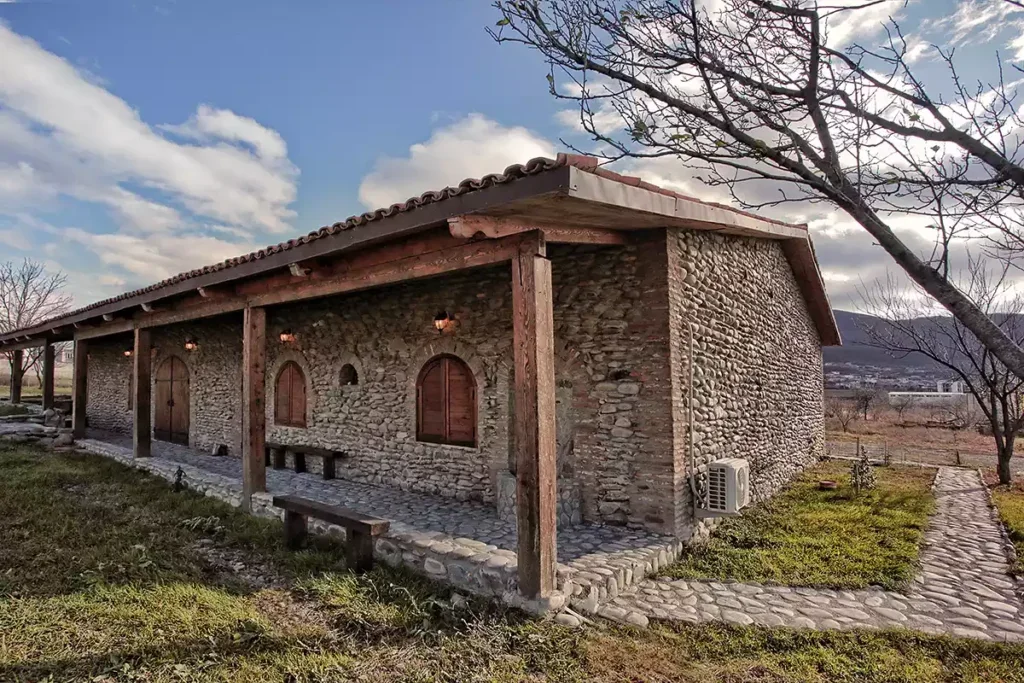
Château Mukhrani is a completely different enterprise, one of Georgia’s midsized and thoroughly professional wineries, consistently producing some of Kartli’s top wines. From the 19th century onward, Georgia has welcomed French know-how and winemaking techniques, and Mukhrani is the current embodiment of this tradition. Its CEO and chief winemaker, German-born and educated Patrick Honnef, worked with Stéphane Derenoncourt in Bordeaux. Honnef still looks after his own small vineyard in the Castillon Côtes de Bordeaux, but in Georgia he is one of the few actively searching for terroir. “We’re trying to understand this land and these varieties, trying to see what they both can do,” he says. He is “looking for the mineral thread, the tension,” in the white varieties and how they express themselves differently in different soils and through different vinification techniques. Honnef brings a thoroughly Western analytic framework to Georgia, though his team is thoroughly Georgian. “Our situation in Kartli is very different from the conditions in Kakheti,” he says. “It is cooler. Our season is behind Kakheti’s, both in the spring and at harvest. And the soils are lighter. When I was invited to work in Georgia, what sealed the deal for me was a flight over the property. I could see the clay/sandy soils around the winery, then the slopes of limestone in [the village of] Mukhrani. I thought, ‘Wow—I can really do something here.’”
The professionals who wrote of Georgian vineyards in the 19th and 20th centuries left a lot about Kartli unexplained. Lacking much historical guidance, Honnef is doggedly trying to understand the Kartli varieties, as well as others that might work in the Mukhrani vineyards—such as Ojaleshi, a variety associated with the western region of Samegrelo. “We work every year to bring full expression of our varieties and vineyards. Which varieties, in which vintages and vineyards, are best suited for stainless steel? For cask? For qvevri? For concrete egg? These are the questions we are asking.” Niko Chochishvili of Kapistoni, who vinifies exclusively in qvevri, agrees that there are still gaps in our knowledge of the region: “In Soviet times, if they weren’t planting vegetables, the grapes were for mass-produced sparkling wines, so it’s up to us now to understand how to produce serious wine here.”
Most of the grapes grown in Kartli in the past century were indeed destined for the off-dry (and often off-tasting) “Soviet Champagne.” But today, in Bastien Warskotte’s hands at Ori Marani, they are being turned into serious fizz. Born and trained in Reims, Bastien made wine in France, South Africa, Canada, and elsewhere around the world before falling in love with a Georgian woman. Ori Marani, in the village of Igoeti, was their first “offspring.”
While spending time with Bastien, we leave the paved road behind; the car trundles up a twisted, winding path to his house and cellar, perched high on the hillside. He dashes around his cellar pulling samples from his barrels filled with different grapes from all over Georgia. “You know Champagne,” he laughs. “We blend.” As he learns how to make wines from these Georgian varieties, he’s also learning the ones he prefers and the specific areas where they grow. The base wines can be fermented in tank, barrel, or qvevri, then he assembles the blends and determines how long the wines should age on the lees. All of the Ori Marani wines have the finesse and brioche-like flavors of a Champagne, but the Georgian grapes impart wisps of musk, earth, and a greater breadth.
Many contend that it really was Iago Bitarishvili who put Kartli—and specifically his own village of Chardakhi—on the world wine map. He has a ready laugh, but underneath lies no shortage of determination. “I’m motivated by the goals I set for myself. To be the first to produce bottled wine, when everyone used jugs; to grow organically; to make natural wine; to export my wines—and so on.” Iago is primarily focused on the local Chinuri variety, which he produces in qvevri, some with skins and some with no skin contact. “Without skins, it is trickier. Since I don’t add commercial yeast, we need the yeast on the skins for the fermentation. So, in some years the no-skin-contact wine has a little sweetness.” Regardless, his Chinuri wines have the telltale aromas and flavors of quince. One of the originators of the Natural Wine Association and the New Wine Festival (an annual springtime event where new vintages are presented), Iago has become so successful that his tiny production is now strictly allocated.
Iago has been trying to increase production slowly, but conditions haven’t been conducive. First, the weather: The first winter after he planted a new vineyard, frost killed 80% of the vines. Second, climate change has made conditions more challenging: “It never snows anymore,” he says. In a recent vintage, he had to carry water from the river below to help some vines suffering from excessive water stress. And third, the legacy of unscrupulous dealing: Most of the grapes he bought weren’t even the Chinuri he had ordered but hybrids and other table grapes he had to grub up.
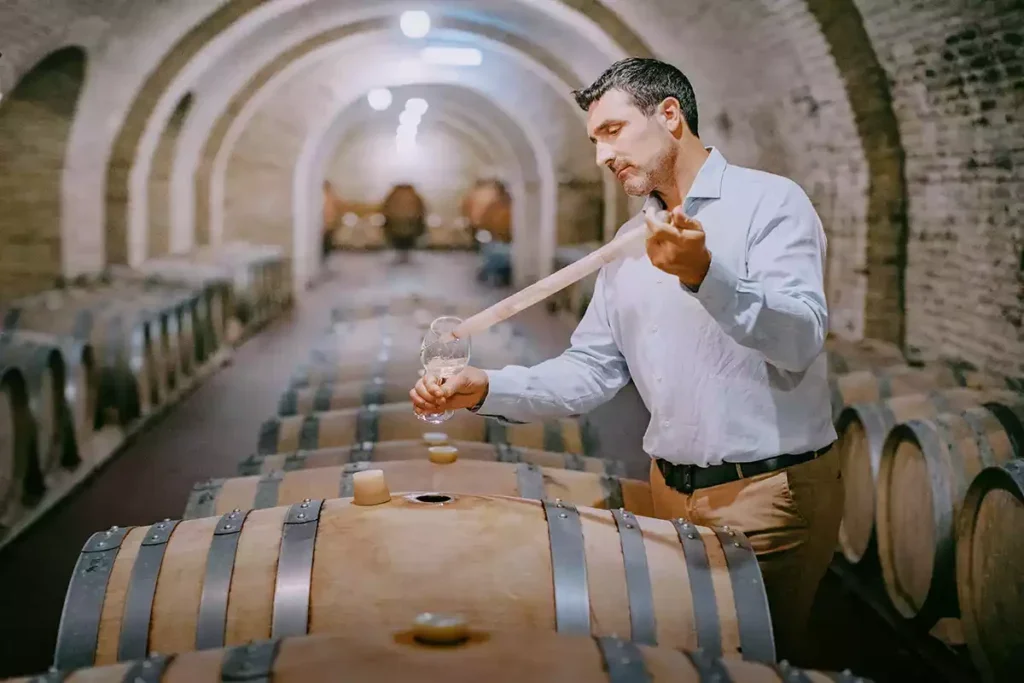
Growing professionalism and recognition
Moving south from Shida Kartli and Tbilisi into Kvemo Kartli, it’s a rough-and-tumble drive down to Bolnisi, passing the scrappy Azerbaijani plumbing- and construction-supply shops strung along the roadway. In medieval times, Georgian, Armenian, and Arab peoples populated the area, but the local character changed in the 19th century, when the Russian imperial government welcomed Swabian settlers fleeing religious persecution; they renamed Bolnisi as Katharinenfeld. (The name reverted to Bolnisi in 1943.) Even though most of the Swabian Germans were forcibly relocated to Siberia during World War II, their imprint remains, notably in the small cellars in their homes and the large wooden vats they used for winemaking.
One of Georgia’s newer PDOs, the Bolnisi appellation lies on both sides of the Mashavera River at altitudes between 1,800 and 2,600ft (550–800m). The western part of the appellation sits on the volcanic Javakheti Plateau. Farther east, the terrain has volcanic rocks, limestone, and sandstone; alluvial soil predominates as one approaches the river. Regardless of soil type, “It’s the winds from two different canyons that really mark the wines and highlight their aromatic profiles,” says the avuncular Guram Avqopashvili, the unofficial ambassador for the family wineries of the area. Most of the vineyards are on the right bank of the Mashavera; the steep vineyards in the villages of Khatissopeli (right bank) and Ratevani (left bank) are already noted as leading sites of the appellation.
“We’re mostly enthusiasts,” acknowledges Guram, who has a small winery with his brother Giorgi (Brothers’ Cellar). “But we think we have one of the most dynamic regions in Georgia, with 13 distinct terroirs. Ten years ago, we had only a handful of wineries and lots of abandoned vineyard terraces, but today we have dozens of small family wineries making wines from Kartli’s indigenous varieties, such as Danakharuli, Shavkapito, and Tavkveri. Plus, we have influences from other Georgian regions. Apart from the Germans, in the 1990s many Svans [from Svaneti, in Georgia’s mountainous northwest] relocated here, bringing their own grape varieties (such as the red Mujuretuli) and their distinctive stone towers, reminiscent of those in Tuscany’s San Gimignano.”
This growth has also been marked by a shift toward more professionalism. “Many Georgians think that they know how to make wine just because they are Georgian,” Niko says wryly. Father Grigor of Bolnisi’s Zedashe Monastery says, “We realized that if we wanted to sell our wines, we had to study winemaking, so the monks enrolled in correspondence courses.” Wines previously fit only for sacramental and symbolic use now have purity and verve. At Shalos Cellar, Tornike Sherazadishvili pursued university studies in wine growing to do right by his grandfather’s vineyard. “I use skin contact not just because it’s our tradition; I know that when I get pear flavors in the skins, I’m going to make a wine that tastes like the totality of the fruit.”
RMG, a local mining company, has underwritten regional development in Bolnisi, including a must-visit local museum displaying artifacts uncovered through their excavations, tracing Bolnisi’s history and culture from prehistory to the present day. In a country that often has multiple “wine festivals” a month, RMG also supports Bolnisi’s own wine festivals and promotional activities. Traditional music fills the air, and dancers enliven the stage as consumers and producers mill about, sampling the latest wines and local snacks like churchkhela (walnuts or hazelnuts dipped in a mix of grape juice and flour, then dried—the original energy bar carried by soldiers and mountaineers) or nemtsuri, a hard, smoked jerky in the German tradition, that pairs beautifully with the red wines.
Driving northwest back toward Tbilisi, we encounter Asureti, another village settled by the Germans. From the hill of Beka Gotsadze’s vineyards across the Asuretiskhevi River gorge, we can see the stone carapace of a Swabian winery. In what is otherwise a deserted area with abandoned vineyards and scrubland, Beka (a former architect before he pivoted to winemaking) planted 15 different indigenous varieties from both eastern and western Georgia in volcanic, heavy clay-loam soils pocked with basalt pebbles and stones. His vineyard is now Demeter-certified, and he adheres firmly to the “natural” philosophy. This has not restricted Beka’s creativity, however. Drawing on his experience of developing heating systems for buildings, he wraps radiant heating tubes around his qvevri. He pumps in cold water to regulate fermentation temperature; as the water itself warms, it fills his swimming pool. Reversing the cycle with warm water encourages the malolactic conversion.
“What’s old always becomes new again,” Niko observes. Preserved primarily through oral tradition and now filtered through a modern sensibility, Kartli’s winemaking past is poised to cultivate some of Georgia’s very finest wines. Producers as different as Chochishvili, Honnef, and Kikvadze are determined to differentiate their wines from those of their neighbors to the east in Kakheti—lighter and more nimble, speaking of place and variety. Kartli’s breakout moment is coming soon, driven by the energy and drive of its winemakers. Or perhaps it’s already here…

